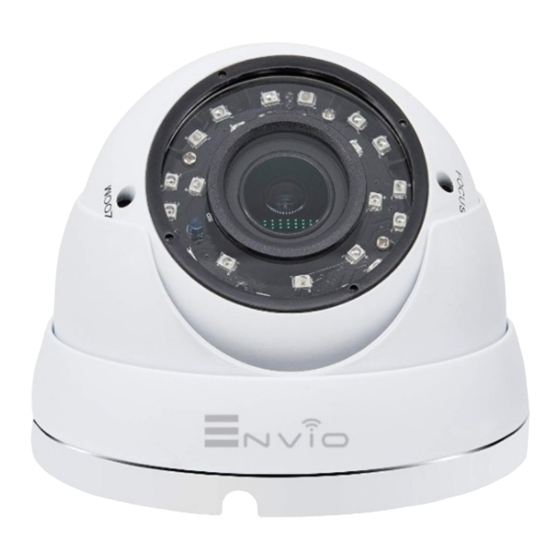
Table of Contents
Advertisement
Quick Links
Luna Series
|
AESS-DVM70H500ST
AESS-DVM70H500ST
5MP Varifocal Dome Hybrid Camera
Technical Specification
Camera
Image Sensor
1/2.9"SONY STARVIS CMOS
Effective Pixels
2592(H)×1944(V),5MP
Scanning System
Progressive
Minimum Illumination
0.001Lux/F1.6, 30IRE, 0Lux IR on
IR Distance
30m
IR On/Off Control
Auto / Manual
IR LEDs
24pcs smd IR LED
Lens
Lens Type
Fixed Lens
Focal Length
2.8-12mm
Angle of View
100°/45°
Focus Control
Manual
Video
Resolution
2592x1944
Video Output
1-channel BNC high definition video output
Day/Night
Auto (ICR) / Manual
Video Output
OSD Menu
Multi-language
BLC Mode
BLC / HLC / WDR
WDR
WDR
Gain Control
AGC
Noise Reduction
3D
White Balance
Auto / Manual
Smart IR
Auto / Manual
Eelectrical
Power Supply
12V DC ±30%
Power Consumption
Max 3.5W (12V DC, IR on)
Main Features Camera
•
1/2.9" SONY STARVIS
•
(2592x1944)
•
2.8-12mm Varifocal lens
•
Maximum IR Led distance 30m
•
4in1 AHD,HD-CVI, HD-TVI, CVBS (UTC)
•
24pcs smd IR LEDs
•
IP65
•
DC12V
1 Warnings & Precautions
Dear Customer, we thank you for choosing one of our products whose correct use guarantees solutions of the
highest quality and reliability over time. This manual provides instructions for using the product.
2 Connections
Make sure the camera is not powered before making connections.
The video cable is connected to the female bayonet BNC connector, which is then taken to the monitor or DVR
in general via RG59 type coaxial cable and BNC connector. Twisted pair cables can also be used with balun
converters.
Check that the power supply is correct and provided for the camera model used. The use of adequate power
supply units is recommended. 12Vdc / 1A or 12Vdc / 1,5A stabilized is recommended. The pin required is the
standard 5.5 mm. Beware of power extension cables that are too long or have a small section, which could
introduce an excessive voltage drop, especially when the IR illuminator is turned on.
The values expressed in the following table are to be considered at a temperature of 20 ° C [68 ° F].
Conductors section
24 AWG
(AWG)
(0,22mm²)
Resistance value
0.078
(Ώ/m)
Voltage drop
0.028
( V/m)
As the copper conductor section increases, there is a decrease in the resistance value () / m) and therefore in
the voltage drop on the cable itself. Therefore, consider carefully the length and section of the cable during the
design phase. Excessive distances between the power supply and the camera could compromise the correct
functioning of the camera. The acceptable standard of variation of the supply voltage is 12Vdc ± 10%
2.1 Installation
This section indicates how to install the camera on a ceiling or wall with protected cable passage.
Check the solidity of the structure on which you intend to fix the camera, mark the points with a pencil and
drill the holes necessary for its fastening.
3 Dome type camera
Dome cameras consist of the camera unit and the fixing base which are screwed together. Before proceeding
with the assembly, the fixing base must be unscrewed, separating it from the camera body. Generally, no
tools are needed to unscrew the fixing base from the camera body, however, if this is tightened too deeply,
you can help yourself by placing a rigid rod, such as a screwdriver, between the
two lateral cable outlet slots located in the base. The fixing base, separated from the camera, is fixed to the
wall or to the wall with plugs in correspondence with the cable outlet hole and the camera body is
subsequently screwed onto it. Before tightening fully, correctly orient the viewing angle.
3.1 Framing adjustment
Once correctly fixed to the wall / ceiling, point it in the desired direction and lock it (it may vary from model to
model) by tightening the screws with the supplied Allen key.
Fixed lens cameras (IR up to 20m) do not require focus as they are factory set for most applications.
To ensure excellent image quality even in low light conditions, all models are equipped with a Day & Night
function with removal of the IR filter to automatically switch from color to B / W. In addition, all models are
equipped with integrated 850nm IR LED illuminators, for adequate illumination of the area being shot. Be
careful not to install the camera very close to strong light sources or in places subject to reflection of light that
could compromise the correct vision of the camera.
4 OSD menu
Depending on the camera models. This model has a coaxial control:
1. Access the DVR menu in the appropriate coaxial configuration section (in ENVIO DVRs this setting is called
"XVI control". Press the central console button that appears on the monitor to enter the menu home page.
2. Select topic / function of interest using the scroll up / down buttons.
3. Use the left or right buttons to select the different operating modes.
4. Move to [EXIT] and press the center button to exit the setting mode, without saving the settings.
5. Navigate to [SAVE & EXIT] and press the center button to exit the setting mode, saving the settings.
For the full OSD manual visit www.enviosecurity.com
22 AWG
20 AWG
18 AWG
(0,33mm²)
(0,52mm²)
(0,83mm²)
0.050
0.030
0.018
0.018
0.011
0.006
Web: www.enviosecurity.com
EN
Advertisement
Table of Contents

Summary of Contents for ENVIO Luna Series
- Page 1 12V DC ±30% Depending on the camera models. This model has a coaxial control: 1. Access the DVR menu in the appropriate coaxial configuration section (in ENVIO DVRs this setting is called Power Consumption Max 3.5W (12V DC, IR on) "XVI control".
- Page 2 A seconda dei modelli di fotocamera. Questo modello ha un controllo coassiale: 4 Meniul OSD 1. Accedere al menu DVR nell'apposita sezione di configurazione coassiale (nei DVR ENVIO questa În funcție de modelele camerei. Acest model are un control coaxial: impostazione è...













Need help?
Do you have a question about the Luna Series and is the answer not in the manual?
Questions and answers